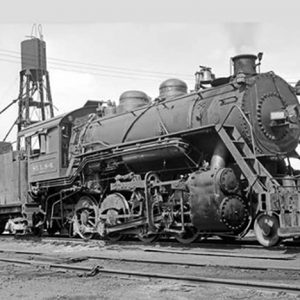calsfoundation@cals.org
Troop Train No. 571 Wreck of 1918
aka: Garland Troop Train Accident of 1918
A northbound St. Louis Southwestern train (No. 571) derailed on the morning of May 21, 1918, at Moyston Station near Garland (Miller County). The train was bound for St. Louis, Missouri, and was carrying a detachment of thirteen soldiers from the 619th Aerial Squadron at Camp MacArthur near Waco, Texas.
The locomotive, a Baldwin K1 2-8-0, pulled one baggage car, two Pullman tourist cars, two Pullman sleeping cars, and a caboose. The train left the station at Texarkana (Miller County) around 7:15 a.m. and derailed at trestle number 972, about 4.3 kilometers (2.7 miles) north of McKinney Station. The trestle measured 140 meters (460 feet) long and 2.4 meters (11 feet) high, except that it rose to a height 7.9 meters (26 feet) where it crossed a pond. The train was running at a speed of about 40.2 km/hr. (25 mi./hr.). The entire train derailed, with the exception of the caboose and one of the sleeping cars. There was considerable damage to the locomotive, tender, and tourist cars.
The train engineer, forty-six-year-old Alex J. McAllister of Pine Bluff (Jefferson County), was killed, as well as Private Oliver C. Shands of St. Louis. Injured Cotton Belt employees included conductor F. E. Chalfant of Pine Bluff; fireman H. G. Counts; brakeman W. W. McKinney of Pine Bluff; Cotton Belt passenger agent L. P. Smith of Chattanooga, Tennessee; “negro porter” Eugene Wade of Memphis, Tennessee; “negro porter” Spence Grant of Dallas, Texas; and “negro porter” Phillip C. Harris of Chattanooga. The injured soldiers included First Lieutenant J. R. Garaghty of Kansas City, Missouri; Sergeant James E. McConnell of Thomaston, Georgia; Corporal Harry L. Misamore of Finley, Ohio; Cook Alfred L. Waters of Elsinore, California; Cook Valentine Giovanni of Fort Wayne, Indiana; Cook Floyd D. Hankins of Silver Valley, Oregon; Cook George H. Webber of Carlton, Kansas; Private Robert R. Kenedy of Chicago, Illinois; Private William T. Vraun of Union Court (state unknown); Private Vincent L. Howell of Roanoke, Virginia; Private James H. Clough of Ashton, South Dakota; and Private James A. Shingler of Wenton, Pennsylvania.
Initial investigation revealed that the first signs of derailment occurred about 52 meters (170 feet) south of the trestle. Some speculation cited that strain on the fishplate bolt that connected the rails together may have been the cause of the accident; however, investigators were unable to find evidence that would suggest a possible reason for the derailment. Statements gathered from previous crewmen who passed over that part of the track a few minutes before indicated that the track was in good condition and safe for a speed of 56 km/hr. (35 mi./hr.). Interestingly, there was even suggestion that German agents were suspected of causing the derailment; however, that was never proven. This may have simply been “propaganda” to further encourage American support of World War I.
For additional information:
“Cotton Belt Troop Train in Wreck—Engineer McAllister is Killed, Fireman Counts Hurt.” Pine Bluff Daily Commercial, May 21, 1918.
“German Agents Blamed for Wreck of C. B. Troop Train.” Pine Bluff Daily Graphic, May 22, 1918.
Interstate Commerce Commission, Bureau of Statistics, Accident Bulletin No. 68. Railway Accidents in the United States During April, May, and June 1918. Printed January 31, 1919.
“Plate Removed, Causing Wreck of Troop Train.” Arkansas Gazette, May 22, 1918, pp. 1, 3.
Strapac, J. A. Cotton Belt Locomotives. Bloomington: Indiana University Press, 1999.
Chris T. McAllister
Eastern Oklahoma State College
James T. McAllister, III
University of Arkansas, Fayetteville







Comments
No comments on this entry yet.